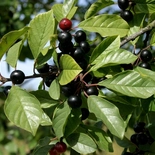This has been a topic of discussion and disagreement for some time. There is finally some research that sheds light on the subject. The answer is: yes, no, maybe, sometimes, and it depends.
This is an excerpt from the Wild Ones Journal
Current members can log in to read the latest issue or check out the Journal Archives.

Glossy Buckthorn(Frangula alnus)
Buckthorns, plants of the genus Rhamnus, produce a metabolite identified as anthraquinone. It is secreted in the fruit, the bark, and the roots. Creatures that ingest any part of the plants are exposed to anthroquinone. If they have the appropriate microflora in their gut, and not all do, the anthroquinone is chemically changed, and emodin is produced. Depending on the concentration of the dose, emodin can have paradoxical effects: it is cathartic (produces diarrhea) at high concentrations, and causes retention of gut content at low concentrations.
The fruit of buckthorns is fleshy. The seed will not germinate while the flesh is present. It must be removed by fruit eaters, either birds while it is on the tree, or insects while the fruit is on the ground. Most of the ground-feeding insects considered, lack the gut-microflora/enzymes to break down anthroquinone to produce emodin. Fruit that germinates under the mother tree does not prosper; it does much better growing at a distance. This may have something to do with the dense shallow root system of a buckthorn, which accounts for the loss of habitat for understory native plants as well.
Genus Rhamnusis indigenous to eastern Europe and Asia. The fleshy fruit, while unripe has been shown to produce high concentrations of emodin. Concentrations reach a peak prior to ripeness of the fruit, and then decrease rapidly. Birds that are indigenous to these same geographic regions, having evolved with the buckthorns, appear to recognize high concentrations of emodin and avoid it. Non-indigenous birds do not, and do not.
The yellow-vented bulbul is indigenous to the same geographic regions as the buckthorns – these organisms have co-evolved over millenia. This bird, it is reported, avoids unripe fruit of the buckthorn, but favors the ripe fruit. The riper the fruit that is eaten, and the longer it is retained in the gut of the bulbul (time interval between defecations is increased), the more fleshy pulp is removed, the more food value of the fruit (food assimilation mass coefficient) is retained by the bird, and the farther from the mother tree the seed is deposited and germinates. Everyone wins.
The buckthorn has been dispersed far and wide around the northern hemisphere – into areas where it is not a native and is not in the presence of frugivores (fruit eaters) with which it has co-evolved. As an example, let us consider the effect of buckthorn in areas in the Northeast and Midwest, where it is an overly abundant, non-native. To the native birds of these areas, the buckthorns are novel introductions, and the birds are unable to discriminate among the concentrations of emodin. Therefore, they eat the fruit of buckthorn whether it is ripe or not. While the fruit is unripe, carrying high levels of emodin, it produces diarrhea in our native birds. If there is little else for the birds to feed on, as might be the case where the buckthorn has taken over an area, the water loss associated with the diarrhea, and unretained food value, may lead to death. Later in the season our native birds may eat the fruit bearing lower concentrations of emodin, and benefit from its food value while the pulpy fruit remains in the gut, to be deposited at a distance from the mother tree.
The information in this article has been pieced together from botanical, ornithological, evolutionary biology, and phytochemistry journals. The spectrum of information gleaned has broad implications with regard to invasive plants, native plants, and the relevance of local genotypes, of coevolution, and plant communities.
We will continue to explore these avenues of information and conclusions in future articles.
By Maryann Whitman

